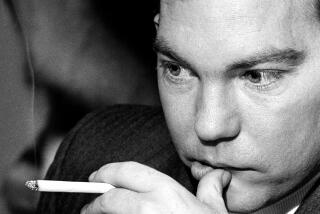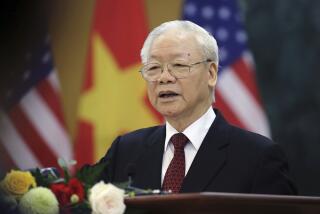Vietnamese Colonel Recalls Attack That Changed War : Tet: 25 years after surprise offensive, commander describes strategy in Hue, where thousands died.
- Share via
HUE, Vietnam — On a cold and clammy afternoon, Huynh Ani takes out his box of military medals to show a visitor. Then he takes out his dentures to talk.
“It was a great victory,” the 67-year-old retired North Vietnamese army colonel says with a toothless grin. “I am still happy.”
It’s been 25 years since the Tet Offensive, when nearly 70,000 Communist soldiers broke a Lunar New Year truce to simultaneously attack more than 100 cities and towns in South Vietnam for the first time. A commando squad even stormed the U.S. Embassy in Saigon, the very symbol of American power.
The audacious attack on Jan. 31, 1968, astonished both U.S. commanders and the American public at home. Although Tet proved to be a military failure for the Communists, neither the war nor America was ever the same.
Fighting was fiercest here in Hue, where Col. Ani commanded 5,500 North Vietnamese and Viet Cong troops in an assault and occupation of the former imperial city. It took 24 long days of bloody house-to-house fighting by U.S. Marines, backed by intense naval shelling and air strikes, to finally dislodge the guerrillas from the walled Citadel on the north bank of the Perfume River.
Nearly 150 Marines and an estimated 5,000 enemy soldiers died during the prolonged battle. But the death toll also includes the worst known atrocity of the war: Nearly 3,000 South Vietnamese soldiers, officials and civilians suspected of government sympathies were executed by the Communists and buried in mass graves. Some were buried alive.
Thin, wiry and animated, Ani wears a blue-and-red wool cap to ward off the winter chill. The former commander lives on a $15-a-month army pension in a small wooden home a short walk from the Citadel. Nearby is an outdoor museum with captured American tanks, howitzers, field artillery and other weapons.
Sitting in a worn rattan chair by his vegetable garden, Ani politely pours hot tea and offers harsh cigarettes to his visitors, then recounts his tale through an interpreter. He apologizes, saying he’s not used to interviews.
Born in Hue, Ani joined the Communist Viet Minh in 1945 to fight the French colonial forces. He lived and fought in jungle-covered mountains west of Hue for most of the next 30 years--at one point not seeing his wife, an army nurse, for 15 years. They had two children in the jungle.
In late 1967, by then commander of the North Vietnamese 6th Regiment, Ani received orders to plan the attack on Hue. His troops celebrated Tet several days early to prepare for the battle. Although U.S. intelligence was warned of a Tet attack, half the South Vietnamese army had been granted holiday leave.
Under cover of darkness and deafening New Year’s Eve fireworks, Ani’s troops slipped into the city from the south, the north and the west on Jan. 31, 1968. “We came very secretly so the U.S. and South Vietnam army do not see us,” he said, sketching the scene with his hands.
They attacked at 3 a.m. They met little resistance from South Vietnamese troops in the Citadel, a small city of Chinese-style temples, tombs and palaces enclosed in thick stone walls. As commander, Ani went quickly to a tall flagpole built atop thick stone ramparts near the south gate.
“My group raised the flag at 4 a.m.,” Ani said proudly. “The man who did it was killed shortly after. But I was very happy. I fulfilled my mission. And after 20 years, I was back in Hue, my home.”
TV viewers worldwide watched his gold-starred People’s Liberation Army flag wave as the battle raged for the next 3 1/2 weeks. Three U.S. Marine battalions, backed by South Vietnamese troops, tenaciously fought their way into Hue. But Ani’s men still controlled the Citadel. Ani’s assessment matches that of U.S. officers at the time.
“The U.S. soldiers have good weapons, so they are very strong,” he said. “And they fight very hard. The South Vietnam army is not so good. When we attack, they run away. But the U.S. army, when they fight in our city, they don’t know the city. They are used to fighting in the jungle.”
Finally, after 10 days, U.S. commanders lifted a ban on bombing the historic complex. Warships in the South China Sea pounded the city from afar, giant howitzers roared and Air Force F-4 Phantoms backed by South Vietnamese A-1 Skyraiders and helicopter gunships attacked from above. Ani says his men survived in deep bunkers and by running toward the Americans, not away.
“We told our men to go close to the U.S. soldiers,” he said, “so the bombs and cannons go behind us. They could not hit us or they would kill the U.S. troops too.”
On the 19th day, Ani said, South Vietnamese troops seized a bridge north of the city to cut their escape. “All my officers were killed at the bridge,” Ani said. Meanwhile, the Marines intensified their attack. On the 24th day, they attacked 10 separate times.
That night, Ani said, he and about 1,200 of his troops slipped away to a nearby village. He says only about 200 Viet Cong died in the battle, a death toll far lower than official U.S. estimates. “I am the commander, so I know,” he insisted.
Ani’s version of the atrocities also is at odds with independent accounts. Survivors at the time said Viet Cong political cadres went house to house with long lists of names. After the battle, nearly 3,000 bodies were exhumed from graves in and around Hue. The victims had been shot, clubbed to death or buried alive.
“Maybe these were people who were caught in the cross-fire,” Ani said. Pressed on the matter, he conceded that civilians were rounded up but said he doesn’t know how many or what happened to them. “The security people had the list,” he said. “But in general, these people were taken away, not killed.”
A former army spokesman and editor of the military newspaper, retired Maj. Gen. Tran Cong Man, is more forthcoming. “We killed civilians who we believed were collaborators with the Republic of South Vietnam,” he said in an interview in Hanoi.
“When we controlled Hue, there was a mistake,” he added. “In Hue, there were Catholics who collaborated with the Republic of South Vietnam. When we controlled the city, we tried to arrest them. But sometimes we also arrested other Catholics who were not collaborators. That was a mistake.”
The Communist atrocities in Hue were overshadowed in the press by accounts of the massacre of 100 civilians by American troops at Mylai in March, 1968. Nor were U.S. officials widely believed when they announced that the Tet Offensive had been a military disaster for the enemy. In fact, the Communists suffered devastating losses: Up to 50,000 seasoned troops, guerrilla leaders and party agents were killed.
But Hanoi ultimately achieved a key goal through Tet: It helped halt U.S. escalation of the war.
Faced with plummeting popularity, President Lyndon B. Johnson rejected a proposal to send 206,000 more men to Vietnam. And on March 31, he announced that he would halt bombing over most of North Vietnam in an attempt to start peace talks. He also announced that he would not run for reelection.
Hue is a dusty, sleepy town now, probably much as it was before the war. Sampans chug slowly down the murky Perfume River, and bicycles far outnumber motorbikes or cars on the streets. Tourists wander past shell-scarred walls and bullet-riddled ruins in the Citadel. UNESCO experts have begun restoring several buildings, but farmers in cone-shaped hats have planted gardens over much of the rest.
Ani pours more tea for his guests and adds a postscript of his own. It’s time for Americans to come back to Vietnam to help the country rebuild in peace, he said.
“For 20 years I hate the Americans,” he said softly. “Now I want to be friends.”
More to Read
Sign up for Essential California
The most important California stories and recommendations in your inbox every morning.
You may occasionally receive promotional content from the Los Angeles Times.











